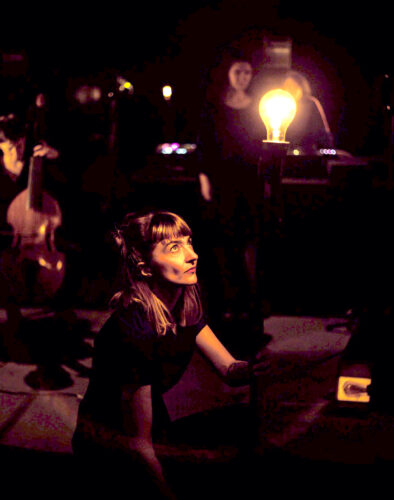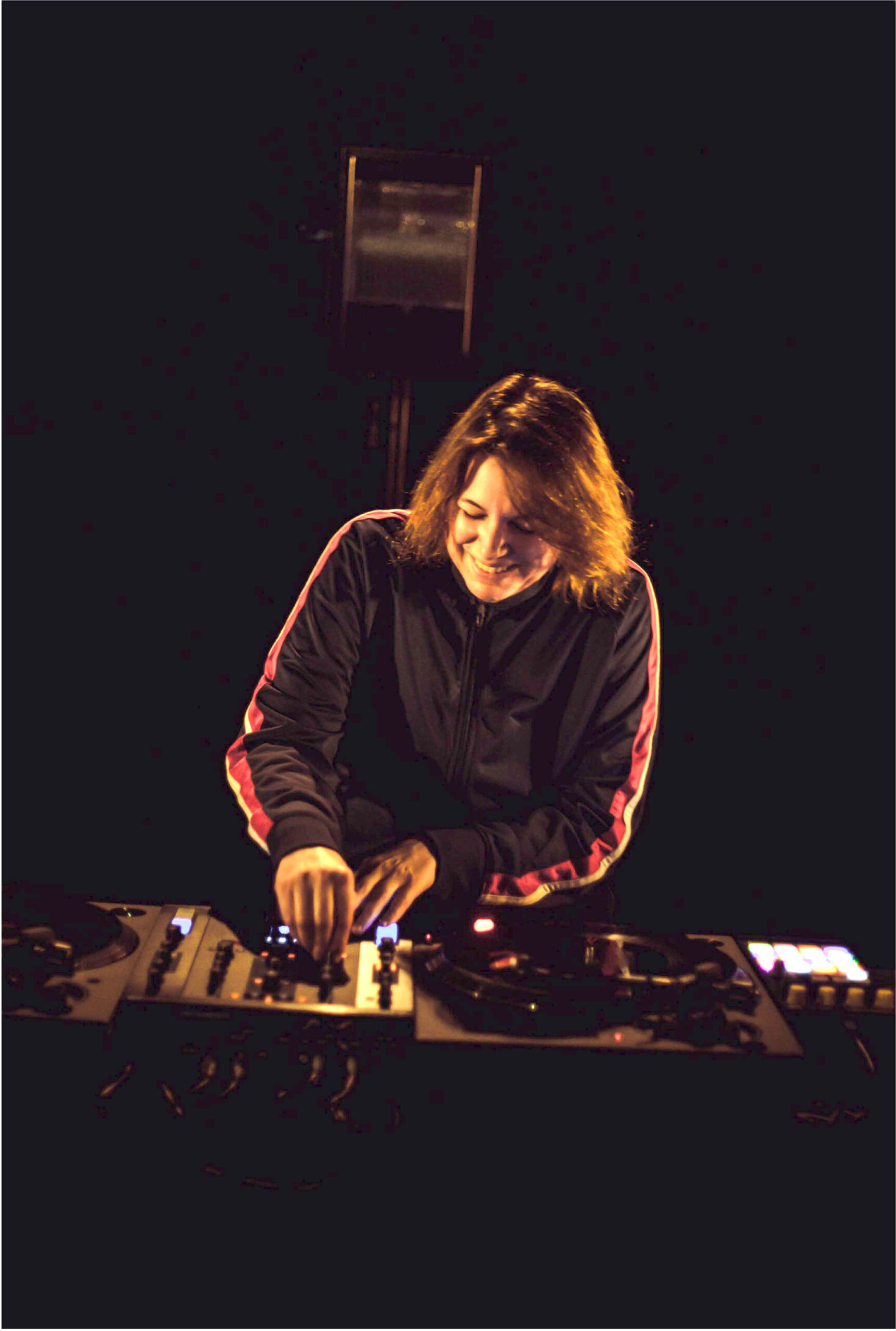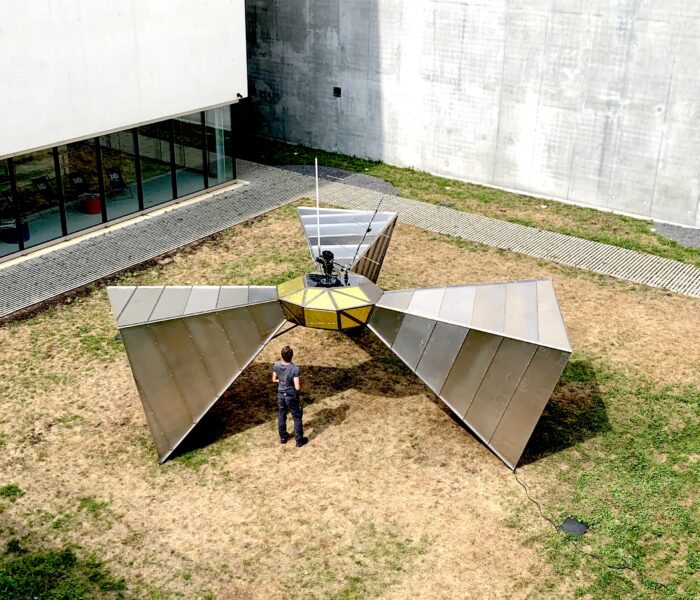Qui-Vive ! Deux mots, un point d’exclamation : tout un programme dissimulé dans le titre du nouvel opus de la Cie Rassegna. Son directeur artistique, le guitariste Bruno Allary embarque quatre musiciennes, entre voix, luth et platines, dans une folle odyssée à la croisée du 17e siècle baroque et des musiques actuelles.
2002-2022 : vingt ans ! Et pour qu’une intuition devienne une vraie démarche, il faut parfois du temps… Lorsqu’il fonde la Compagnie Rassegna, le guitariste Bruno Allary navigue entre jazz, flamenco, et musiques traditionnelles. « A ce moment-là, il était seulement question de réunir autour de moi une espèce de fratrie de chanteurs et de musiciens de Méditerranée que j’accompagnais individuellement. Chanteurs corses, musiciens arabo-andalous, interprètes napolitains, artistes de flamenco… Des artistes qui venaient de musiques qu’on qualifie à tort ou à raison de « populaires ».
L’entre-deux musical : une vraie esthétique
La jeune compagnie, vrai laboratoire, veut croiser les musiques populaires de Méditerranée : faire interpréter un chant des Balkans à un chanteur spécialiste de la polyphonie corse et inversement, ça donnerait quoi ? Des frottements intéressants. « Je voulais provoquer le mélange, le métissage et le contraste pour susciter, chez le public, un rapport intime et vibrant à ces répertoires. C’est ce que j’ai fait pendant les quinze années qui ont suivi ! » Bruno Allary creuse ainsi son sillon dans ce qu’il appelle une « esthétique de l’entre-deux ». « Dans ces répertoires, notamment dans la musique orientale, nous sommes sans cesse à la lisière du tonal, du modal, dans une tension entre deux langages, deux conceptions de la musique… ».
Voyages, voyages
L’entre-deux, la lisière, l’échange et le frottement. La Cie Rassegna s’affirme comme un espace de rencontres, un petit peu à l’instar de ce bassin méditerranéen dont elle défend le patrimoine musical millénaire… En 2014, son travail prend un virage nouveau, à l’origine du triptyque dont « Qui-Vive ! » sera le dernier maillon. Comme souvent – et peut-être plus encore quand on s’intéresse aux métissages musicaux – c’est affaire de rencontres. Bruno Allary invite ainsi Mireille Collignon et ses violes de gambe à rejoindre la Compagnie. Cette fois, le répertoire renaissance du 16e siècle intéresse les musiciens. Alors ils imaginent, expérimentent, tentent…« Pourquoi ne pas associer des instruments connotés musique ancienne avec… la guitare électrique?»


Renaissance et guitare électrique
Un compagnonnage fécond qui aboutit à la création de « Il Sole non si muove ». Le but, là encore : décloisonner. « Ce premier volet du triptyque mêle les répertoires populaires et savants et retrace la circulation, intense, des musiciens du 16e siècle, de la Méditerranée à l’Angleterre. » Là encore, le défi est de taille : « Comment faire cohabiter des musiques qui viennent de l’oralité, en perpétuel mouvement, avec des musiques écrites ? » résume Bruno Allary. Des difficultés, il y en a eu. « D’un point de vue purement artistique, la question du tonal et du modal est délicate. Mettre ensemble des instruments ou des chanteurs de la partie latine de la Méditerranée, occidentalisée, et des musiciens qui viennent d’Orient, nous confronte en permanence à l’utilisation des modes, des micro-intervalles. Si le quart de ton est un peu plus comme ceci, c’est davantage iranien, s’il est plus comme cela, c’est plutôt anatolien… Tout est d’une grande subtilité et la cohabitation est passionnante. »
Circulation des musiques
Bruno Allary constate alors à quel point le clivage « savant » et « populaire » est prégnant en France. « Je donnais récemment une conférence virtuelle avec des étudiants en musicologie au Brésil, et j’ai compris au bout de cinq minutes qu’il n’y avait pour eux aucune séparation entre le populaire et le savant. Cela n’existe pas ! » En 2014, le projet de Rassegna n’entre dans aucune case. Qu’importe : quatre ans plus tard, le deuxième volet s’élabore : après la Renaissance, place aux musiques de Moyen-âge. Le spectacle « Contretemps », présenté à La Crié de Marseille, explore la poésie médiévale dans une nouvelle machine à remonter les sons. Au programme : flûtes kaval, guitares baroques et électriques (toujours) et des textes du philosophe et historien Patrick Boucheron.
A travers les âges
Musique médiévale, renaissance et, naturellement, baroque. Le triptyque musical se clôture cette année avec la sortie, au disque (Buda Music), de « Qui-Vive ! » Un troisième opus né d’une commande passé par le théâtre Durance, scène conventionnée à Château-Arnoux-Saint-Auban (Alpes-de-Haute-Provence). « Deux des musiciennes que j’ai convoquées pour le projet viennent des musiques anciennes, la flûtiste à bec Clémence Niclas, membre du jeune ensemble Apotropaïk, qui chante très bien, et la joueuse de viole de gambe Nolwenn Le Guern. A la première répétition, j’avais apporté pleins d’instruments, comme je fais toujours, car je ne savais pas encore comment allait sonner ce projet. J’ai demandé si quelqu’un voulait jouer de la basse électrique, « moi moi moi ! » a répondu Nolwenn. Depuis toujours, elle rêvait de jouer de la basse dans un groupe de rock… »
Purcell, batterie, scratch
La chanteuse de fado Carina Salvado se joint également au projet, « elle est capable de chanter Purcell tout en jouant de la batterie », s’amuse Bruno Allary. Le guitariste contacte également une DJ, championne de France et vice-championne du monde de scratching : Isa L. Atipik. « Travailler sur les répertoires du 17e siècle est très intimidant, confie Allary. Je viens d’une musique qui se joue dans la rue, dans les bars. Comment on s’attaque à Purcell, à Monteverdi ? Quand je viens vers ces musiques dîtes savantes, je me demande si je suis légitime. Si je voulais être un petit peu polémique, je dirais que la réciproque n’est pas toujours vraie. Quand les musiciens de musique savante s’emparent de musiques populaires, ils se posent moins de questions. Que puis-je apporter à ces répertoires qui sont joués, la plupart du temps, de manière magistrale ? Oui je dois respecter, travailler, me documenter, mais je dois trouver une place, oser le pas de côté ! Je peux leur apporter un petit peu de ce que ces musiques ont, selon moi, perdues, un petit peu de grain, de craquements…”
Jeu de miroirs sonores
Quand il découvre la basse obstinée, les ostinato baroques, séquences mélodiques, rythmiques, qui tournent, Bruno Allary fait le parallèle avec les musiques de transe où l’intérêt réside dans la récurrence. « Et qu’est-ce qui tourne et qui frotte, qui craque ? La platine vinyle ! On a là un objet emblématique des musiques urbaines, actuelles, qui trouve sa place, de manière détournée, dans le répertoire baroque. » Les platines ne sont donc pas mobilisées dans le projet pour « s’encanailler », mais symbolisent bien toute la démarche de « Qui-vive ! » Isa L. Atipik a enregistré des boucles de flûte, de viole, de voix, de guitare, de basse, pour se créer tout une petite bibliothèque de samples.



Frescobaldi, Boesset, Zanetti, Bailly, Purcell, Barbara Strozzi : des raretés, quelques tubes, dont Bruno Allary et les musiciennes proposent des reprises ciselées, étonnantes, bruissantes, saupoudrées d’électro. Ces pages baroques audacieusement arrangées prennent ainsi un relief complètement inédit : flûtes à bec électrisées, violes de gambe en tension, des basses continues scratchées sur des platines vinyles ou des boucles augmentées à partir des guitares électriques. Pour parfaire l’expérience, le propos de « Qui-Vive ! » est construit autour d’une narration théâtrale : un prologue, trois actes (théâtre de l’amour, de la folie, de la mort) et un épilogue poétique où les musiciennes brodent sur ce vers de Théophile de Viau, aux allures de manifeste en 2022 : « Ici, mon désir est ma loi ».
Suzanne Gervais
Retrouver en concert Qui vive! et la Cie Rassegna le 22 septembre à 20h30 au Studio de l’Ermitage, Paris.



)



